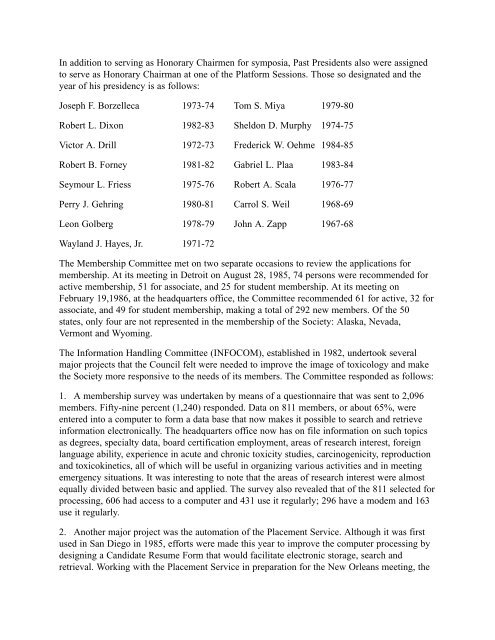SOCIETY O. TOXICOLOGY HISTORY - Society of Toxicology
SOCIETY O. TOXICOLOGY HISTORY - Society of Toxicology
SOCIETY O. TOXICOLOGY HISTORY - Society of Toxicology
You also want an ePaper? Increase the reach of your titles
YUMPU automatically turns print PDFs into web optimized ePapers that Google loves.
In addition to serving as Honorary Chairmen for symposia, Past Presidents also were assigned<br />
to serve as Honorary Chairman at one <strong>of</strong> the Platform Sessions. Those so designated and the<br />
year <strong>of</strong> his presidency is as follows:<br />
Joseph F. Borzelleca 1973-74 Tom S. Miya 1979-80<br />
Robert L. Dixon 1982-83 Sheldon D. Murphy 1974-75<br />
Victor A. Drill 1972-73 Frederick W. Oehme 1984-85<br />
Robert B. Forney 1981-82 Gabriel L. Plaa 1983-84<br />
Seymour L. Friess 1975-76 Robert A. Scala 1976-77<br />
Perry J. Gehring 1980-81 Carrol S. Weil 1968-69<br />
Leon Golberg 1978-79 John A. Zapp 1967-68<br />
Wayland J. Hayes, Jr. 1971-72<br />
The Membership Committee met on two separate occasions to review the applications for<br />
membership. At its meeting in Detroit on August 28, 1985, 74 persons were recommended for<br />
active membership, 51 for associate, and 25 for student membership. At its meeting on<br />
February 19,1986, at the headquarters <strong>of</strong>fice, the Committee recommended 61 for active, 32 for<br />
associate, and 49 for student membership, making a total <strong>of</strong> 292 new members. Of the 50<br />
states, only four are not represented in the membership <strong>of</strong> the <strong>Society</strong>: Alaska, Nevada,<br />
Vermont and Wyoming.<br />
The Information Handling Committee (INFOCOM), established in 1982, undertook several<br />
major projects that the Council felt were needed to improve the image <strong>of</strong> toxicology and make<br />
the <strong>Society</strong> more responsive to the needs <strong>of</strong> its members. The Committee responded as follows:<br />
1. A membership survey was undertaken by means <strong>of</strong> a questionnaire that was sent to 2,096<br />
members. Fifty-nine percent (1,240) responded. Data on 811 members, or about 65%, were<br />
entered into a computer to form a data base that now makes it possible to search and retrieve<br />
information electronically. The headquarters <strong>of</strong>fice now has on file information on such topics<br />
as degrees, specialty data, board certification employment, areas <strong>of</strong> research interest, foreign<br />
language ability, experience in acute and chronic toxicity studies, carcinogenicity, reproduction<br />
and toxicokinetics, all <strong>of</strong> which will be useful in organizing various activities and in meeting<br />
emergency situations. It was interesting to note that the areas <strong>of</strong> research interest were almost<br />
equally divided between basic and applied. The survey also revealed that <strong>of</strong> the 811 selected for<br />
processing, 606 had access to a computer and 431 use it regularly; 296 have a modem and 163<br />
use it regularly.<br />
2. Another major project was the automation <strong>of</strong> the Placement Service. Although it was first<br />
used in San Diego in 1985, efforts were made this year to improve the computer processing by<br />
designing a Candidate Resume Form that would facilitate electronic storage, search and<br />
retrieval. Working with the Placement Service in preparation for the New Orleans meeting, the
















